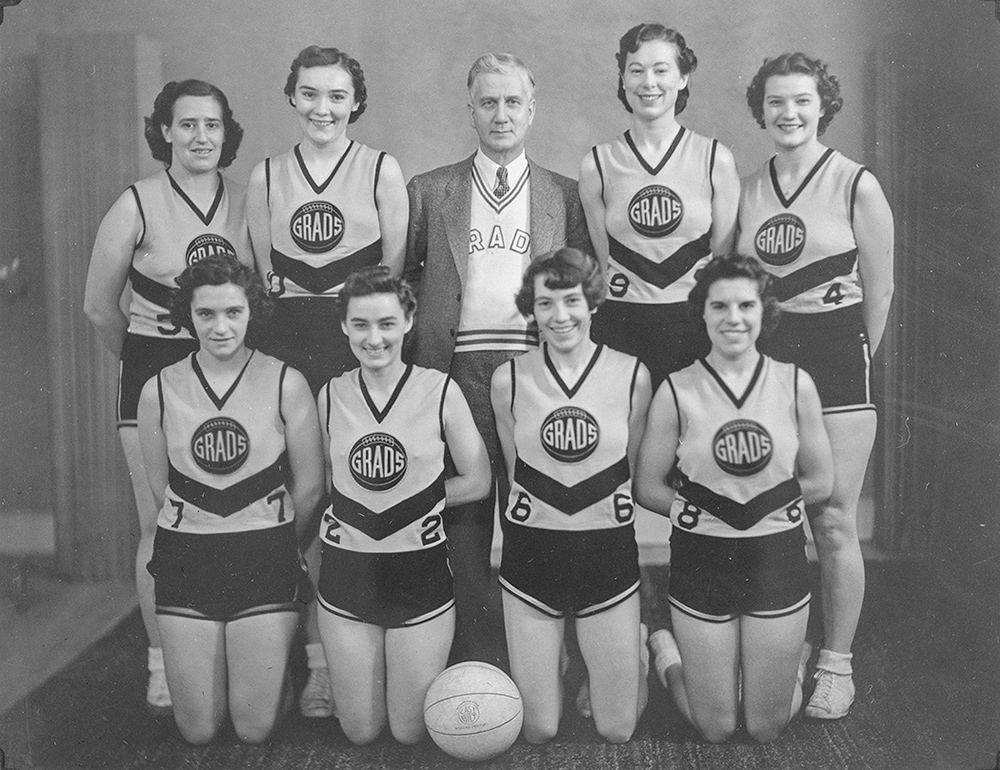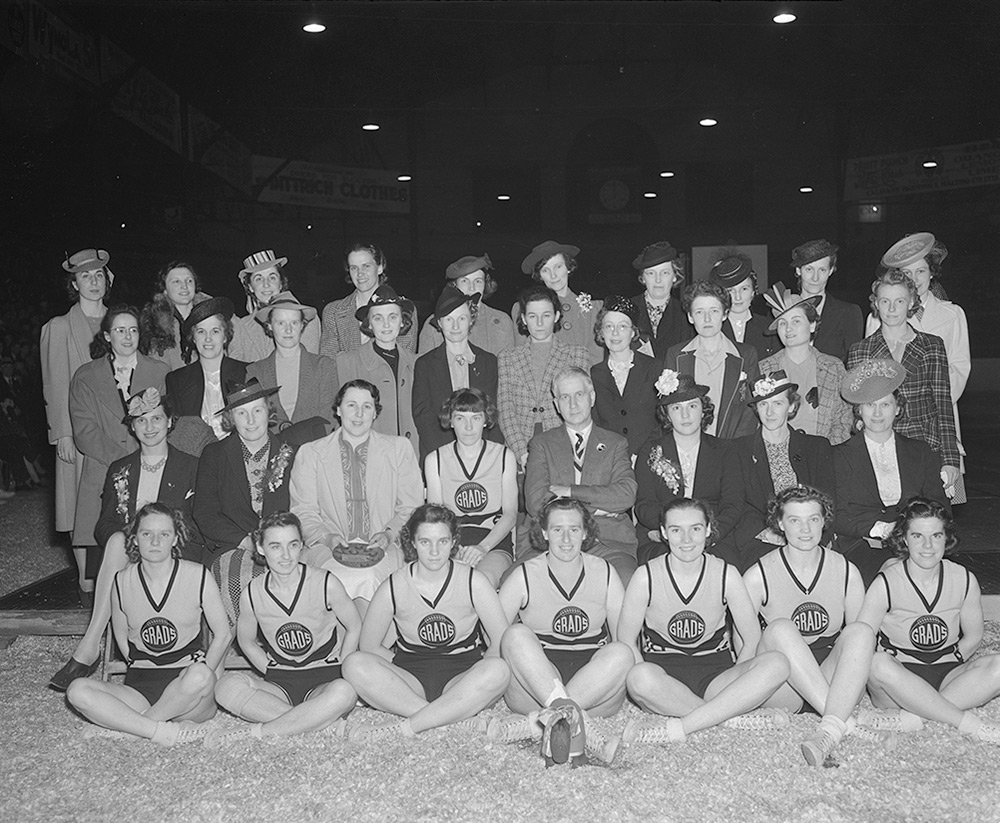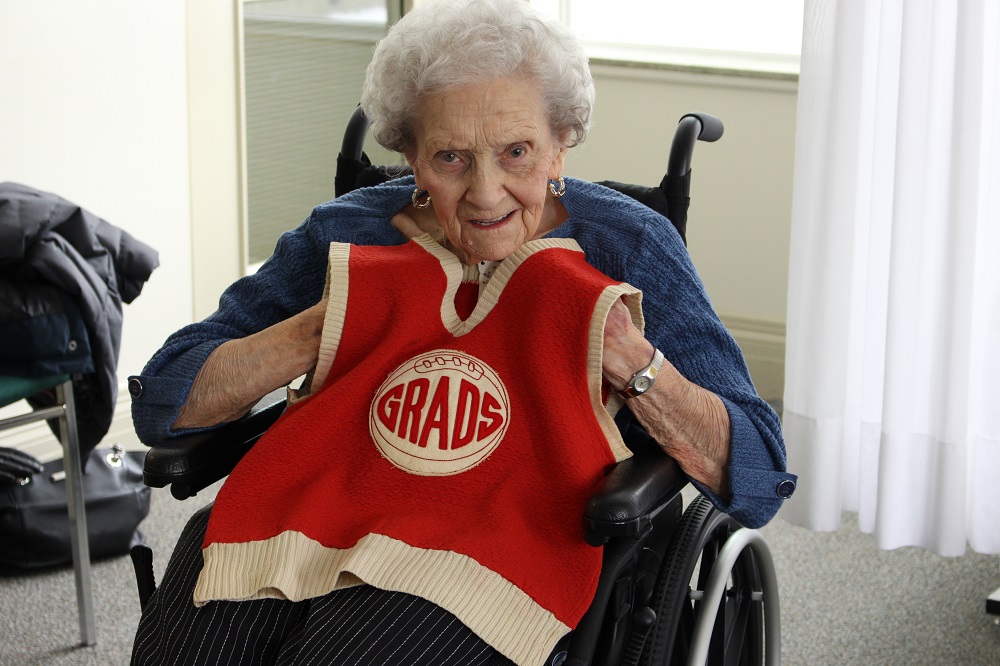
The Beginning
Basketball was a relatively young game when the Edmonton Grads formed in 1915. The sport had been invented in 1891 by James Naismith, a Canadian working at the YMCA International Training School in Springfield, Massachusetts. Like most other sports, it was originally intended for male players, but it wasn’t long before females began playing as well. By the late 1890s, young women were playing basketball at high schools (e.g., Windsor Collegiate Institute in Ontario), universities (e.g., University of Toronto) and the YWCA, and had begun to establish women’s basketball clubs (e.g., Ladies Basketball Club of Toronto).
Girls first started playing basketball in Alberta high schools in 1904. Ten years later, in 1914, a girls’ basketball team was formed at MacDougall Commercial High School. Coached by teacher Percy Page, the team won Edmonton’s high school league in 1914 and won the intercollegiate basketball league as well as the Alberta provincial championship the following year. At the end of the 1915 season, graduating members of the team decided to continue playing basketball and formed the Commercial Athletic Society (later the Commercial Graduates Basketball Club). The society was open to students and graduates of MacDougall Commercial, and to members of other business schools as well as those already pursuing a career in business. They soon became known as the Commercial Graduates and eventually the “Grads.”
Commercial Graduates Basketball Club
In addition to the Grads, the Commercial Graduates Basketball Club included the junior and senior high school teams, a junior ladies’ team (the Cubs) for those still at school or recently graduated, and an intermediate team (the Gradettes) for talented players who could move up to the Grads once a vacancy opened. This “feeder” system ensured continuity, cohesion and depth, which contributed to the success of the Grads. The teams won numerous championships at the high school and provincial levels, prior to the Grads’ victory at the first Dominion (national) championship in 1922.
Page either coached or supervised all the teams, and his influence on the Grads was clear. “You must play basketball, think basketball and dream basketball,” he told his players. The Grads practised twice a week — usually Mondays and Thursdays — from September to June. As the players also worked full-time, practices were held in the evenings from about 8:00 to 9:30 p.m. The Grads and Gradettes usually practised together, either working on drills or simulating game situations. Page and his assistant coaches emphasized accuracy and teamwork. Consequently, the Grads were known for their short-passing game. After the Grads switched to playing men’s rules in 1923, they also practised against the Boy Grads in the lead-up to big games.
Page expected discipline, sportsmanship and ladylike behaviour from his players, although he did not require adherence to a specific code of conduct. His slogan was, “Ladies first, basketball players second.” As they were respectable working women, Page expected them to behave as such, dressing appropriately and avoiding smoking, drinking and disreputable company. Page and his wife Maude, who acted as team chaperone, formed a family of sorts with the players, some of whom referred to him as “Papa Page.” This closeness may help to explain both the team’s success and the fact that there was so little turnover of players. Players generally resigned from the team when they married, although not all did so.
Team History and Record
In 1922, the Edmonton Grads won their first national championship, defeating the London Shamrocks, the eastern champions from London, Ontario, in two games with a combined score of 49–29. The first game was played according to women’s rules (six players), while the second game was played according to men’s rules (five players). Until this point, the Grads had only played using women’s rules, although they would adopt the less restrictive men’s rules the following year. They easily won the first match 41–8, while the Shamrocks, who favoured men’s rules, won the second match 21–8. However, the Grads’ overall score was higher, which clinched the championship. They successfully defended their national title until the team disbanded in 1940.
Only a year after winning their first national championship, the Grads competed for the first Underwood Trophy, a “world championship” competition between the American and Canadian champion teams. Their opponents, the Cleveland Favorite-Knits, wore shorts already bearing the words “World Champs.” This confidence was misplaced, however. The Edmonton Grads played two games against the Cleveland team, defeating them with a combined score of 53–33. Over the next 17 years (1923–40), the Grads defended their title against numerous challengers, winning most of their matches. In their 25th and final season, they received the Underwood International Trophy as a permanent possession.
The Grads proved their dominance in overseas matches as well. The team participated in matches organized by the Fédération sportive féminine internationale and held in conjunction with three Olympic Summer Games (1924, 1928 and 1936). The Grads won all 24 games, defeating their opponents by large margins. In 1928, for example, they beat the Équipe de Paris by a score of 109–20. In recognition of their dominance, the Grads were named world champions. However, the team did not bring home any Olympic medals; the International Olympic Committee did not organize the matches, and women’s basketball was not an official Olympic event at the time. Women first started competing at the Olympics in 1900, in five sports: golf, equestrian, sailing, croquet and tennis. By 1936, archery, aquatics, gymnastics and athletics (track and field) had been opened to women’s participation at the Summer Games. Women’s basketball did not become an official Olympic event until 1976.
Traditionally, the Grads are considered to have played 522 games in total, winning 502 and losing only 20. However, these numbers have been challenged by M. Ann Hall, author of The Grads Are Playing Tonight! (2011). According to Hall, the Grads played over 400 games during their 25 years as a team, losing 20. She explains that the higher total (522) includes games played by the MacDougall Commercial junior and senior high school teams in the period from 1915 to 1922, as well as those played by the Grads themselves. Moreover, there are some discrepancies in the records pertaining to games played between 1922 and 1940. While a definite number may never be achieved, there is no debate that the Grads were an exceptional team, winning around 95 percent of their matches.

Edmonton Grads Players
The first McDougall Commercial High School team (1914) comprised forwards Nellie Batson and Ella Osborne, centres Ethel Anderson and Mary Bremner, and guards Geraldine Reid and Iola Mitchell. Late in 1915, Winnie Martin joined them. In 1917, when the Edmonton Grads officially began competing, the team included Batson, Osborne, Anderson, Martin and Reid, as well as Elena Todd, a star player from the senior high school team. Between 1917 and 1922 (when the team won its first national championship), a number of players came and went, including Alfretta Dickson, Connie Lamont, Mona Karren, Kathleen Hall and Dorothy Shaw. Most of these players are not recognized among the “official” 38 members of the Edmonton Grads, which only includes players from 1922 to 1940. The table below lists the 38 official Grads. Full biographies can be found in M. Ann Hall’s The Grads Are Playing Tonight! (2011).
|
Official Edmonton Grads (Years Playing With the Team)
|
|
Winnie Martin Tait (1915–24) Born 28 September 1899 in Petrolia, Ontario Died 27 April 1974 in Vancouver, British Columbia |
|
Elizabeth Elrick Murray (1918–23) Born Elizabeth Elrick on 15 January 1901 in Glasgow, Scotland Died 29 June 1984 in Winnipeg, Manitoba |
|
Eleanor Mountifield Vogelsong (1919–24) Born Eleanor Mountifield on 20 May 1902 in Fort Yukon, Alaska Died 5 February 1985 in Lewistown, Idaho |
|
Connie Smith McIntyre (1920–26) Born Constance Smith on 5 October 1903 in Walsall, Staffordshire, England Died 9 January 1990 in Viking, Alberta |
|
Daisy Johnson (1920–27) Born Margaret Jane Johnson on 26 November 1902 in Jumping Pound, Alberta Died 16 March 1979 in Edmonton, Alberta |
|
Nellie Perry McIntosh (1921–24) Born Ellen Perry on 4 February 1903 in London, England Died 16 April 1991 in Victoria, British Columbia |
|
Dot Johnson Sherlock (1921–27) Born Dorothea Lily Johnson on 22 January 1906 in Jumping Pound, Alberta Died 20 March 2003 in Kelowna, British Columbia |
|
Abbie Scott Kennedy (1922–24) Born Abigail Esther Scott on 6 October 1902 in Cheyenne, Wyoming Died 24 February 1991 in Edmonton, Alberta |
|
Mary Dunn Dickson (1922–26) Born Mary Dunn on 6 March 1902 in Hamilton, Scotland Died 4 August 1996 in Calgary, Alberta |
|
Helen McIntosh Davidson (1923–24) Born Helen McIntosh on 23 December 1905 in Toronto, Ontario Died 28 October 1975 in Chilliwack, British Columbia |
|
Elsie Bennie Robson (1925–34) Born Elsie Norrie Bennie on 10 May 1908 in Stirling, Scotland Died 15 June 1999 in Calgary, Alberta |
|
Harriett (Hattie) Hopkins (1925–27) Born Harriet McCleave Hopkins on 12 March 1908 in Bangor, County Down, Northern Ireland Died 13 August 1954 in Vancouver, British Columbia |
|
Kate Macrae Shore (1925–29) Born Catherine Macrae on 16 July 1905 in Glasgow, Scotland Died 17 September 1945 in Springfield, Massachusetts |
|
Marguerite Bailey Jacobs (1926–27) Born Marguerite Bailey on 31 October 1906 in Toronto, Ontario Died 28 October 1992 in Vancouver, British Columbia |
|
Mildred McCormack Wilkie (1926–32) Born Mildred Ruth McCormack on 21 June 1909 in Buffalo, New York Died 10 May 1991 in New Westminster, British Columbia |
|
Margaret MacBurney Vasheresse (1926–35) Born Margaret MacBurney on 9 April 1909 in Fernie, British Columbia Died 27 June 2007 in Edmonton, Alberta |
|
Joan Johnston McEwen (1927–29) Born Joanna Johnston in April 1907 in Alberta Died December 1989 |
|
Mae Brown Webb (1927–30) Born Mary Brown on 15 August 1903 in Minnedosa, Manitoba Died 7 April 2000 in Edmonton, Alberta |
|
Gladys Fry Douglas (1927–36) Born Gladys Alberta Fry on 26 February 1907 near Kitscoty, Alberta Died 17 March 1991 in Calgary, Alberta |
|
Margaret Kinney Howes (1929–30) Born Margaret Kinney on 1 February 1912 in Edmonton, Alberta Died 9 September 1995 in Montréal, Québec |
|
Doris Neale Chapman (1929–36) Born 26 June 1911 in Ottawa, Ontario Died 27 February 1992 in Edmonton, Alberta |
|
Noella “Babe” Belanger MacLean (1929–37) Born Noella Belanger on 8 May 1911 in Edmonton, Alberta Died 7 January 1999 in Edmonton, Alberta |
|
Edith Stone Sutton (1931–34) Born Edith Stone on 9 April 1910 in Edmonton, Alberta Died 9 May 2012 in Edmonton, Alberta |
|
Helen Stone Stewart (1931–34) Born Helen Stone on 9 April 1910 in Edmonton, Alberta Died 24 June 2011 in Vancouver, British Columbia |
|
Evelyn Coulson Cameron (1933–34) Born Evelyn Coulson on 28 January 1912 in Calgary, Alberta Died 11 February 2001 in Edmonton, Alberta |
|
Jessie Innes Maloney (1933–34) Born Jessie Innes on 16 January 1911 in Edmonton, Alberta Died August 1987 in Edmonton, Alberta |
|
Noel MacDonald Robertson (1933–39) Born Noel Marguerite MacDonald on 23 January 1915 in Mortlach, Saskatchewan Died 13 May 2008 in Edmonton, Alberta |
|
Mabel Munton McCloy (1933–40) Born Mabel Munton on 30 March 1914 in Winterburn [Edmonton], Alberta Died 16 January 1994 in Edmonton, Alberta |
|
Helen Northup Alexander (1934–40) Born Helen Northup on 16 March 1916 in Arcadia, Florida Died 15 May 2009 in Sidney, British Columbia |
|
Etta Dann Soderberg (1935–40) Born Etta Dann on 29 March 1913 in Edmonton, Alberta Died 22 August 1978 in High River, Alberta |
|
Sophie Brown Drake (1935–40) Born Sophia Brown on 21 September 1916 in London, England Died 4 July 1986 in Victoria, British Columbia |
|
Betty Ross Bellamy (1936–39) Born Mary Elizabeth Ross on 3 April 1914 in Edmonton, Alberta Died 16 May 2010 in Kelowna, British Columbia |
|
Winnie Gallen Reid (1936–37 and 1939–40) Born Winnifred Phyllis Gallen on 4 July 1917 in Mawer, Saskatchewan Died 5 February 1996 in Edmonton, Alberta |
|
Frances Gordon Mills (1937–38) Born Frances Gordon on 19 January 1915 in Red Deer, Alberta Died 14 April 2004 in Red Deer, Alberta |
|
Muriel “Babe” Daniel Loughlin (1937–39) Born Muriel Rosamond Daniel on 30 May 1917 in Camrose, Alberta Died 5 October 1995 in British Columbia |
|
Jean Williamson Quilley (1937–40) Born Jean Williamson on 4 February 1919 in Edmonton, Alberta Died 3 March 2003 in Medicine Hat, Alberta |
|
Betty Bawden Bowen (1939–40) Born Betty Bawden on 22 December 1917 in Edmonton, Alberta Died 17 October 2007 in Oakville, Ontario |
|
Kay MacRitchie MacBeth (1939–40) Born Kay MacRitchie on 22 January 1922 in Saskatoon, Saskatchewan Died July 2018 in Toronto, Ontario |

The End of a Dynasty
In 1940, the Edmonton Grads disbanded. There were several reasons for this decision, including the loss of their arena, which had been taken over by the government for the Air Force Commonwealth Training Program. Wartime conditions made travel difficult and led to the cancellation of many competitions in Canada, the United States and in Europe; moreover, there were few teams good enough to compete with the Grads. Finally, attendance at games had declined; and, in 1940, Page was elected to the provincial government. Page served in the Alberta legislature from 1940 to 1959, and was lieutenant-governor of Alberta from 1959 to 1966.
Although the team disbanded, it supported the formation of two women’s basketball teams: the Comets and the Starlets. Several of the Grads played for the Comets — Noel MacDonald, Betty Bawden, Etta Dann, Helen Northrup, Winnie Gallen and Kay MacRitchie — which competed for titles at the provincial, national and international level. However, they never achieved the same success as the Grads. In 1941, MacRitchie moved to Vancouver and joined the Hedlunds, who dominated women’s basketball in Canada for the next few years.

Significance
The Edmonton Grads were the dominant women’s basketball team of the early 20th century, with a record that most teams today would envy. They played to capacity crowds, attracting thousands of spectators and brought fame to the city, as their victories were reported in newspapers across the country and overseas. In 1923, for example, the story of the team’s success in the Underwood Trophy competition was carried by most major newspapers in Canada, 300 daily papers in the United States, and publications in Hong Kong, the Philippines and Cuba.
In 1936, James Naismith, the Canadian inventor of basketball, wrote a letter to the Grads:
You are not only an inspiration to basketball players throughout the world, but a model of all girls’ teams. Your attitude and success have been a source of gratification to me in illustrating the possibilities of the game in the development of the highest type of womanhood.
Their fame and success are particularly significant, given concerns at the time about women’s involvement in sports. Although many historians consider the 1920s a “golden age” of women’s sport, with the emergence of teams like the Grads and individual athletes such as Fanny “Bobbie” Rosenfeld and Ethel Catherwood, some Canadians disapproved of female athleticism. Naismith’s reference to the “highest type of womanhood” and Page’s emphasis on ladylike behaviour reflected concern that sports were too strenuous for women, and that vigorous physical activity could have negative physical and moral consequences. The team’s reputation for athletic excellence and ladylike behaviour helped to promote the positive aspects of women’s sporting endeavours and served as an inspiring example for the many female athletes who would follow. (See also The History of Canadian Women in Sport.)
Acknowledgements
Sincere thanks to M. Ann Hall for her help in reviewing and suggesting revisions to this article.

 Share on Facebook
Share on Facebook Share on X
Share on X Share by Email
Share by Email Share on Google Classroom
Share on Google Classroom


